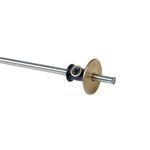
Synopsis: If you want a finish that’s as tough and strong as baked enamel, more resilient than polyurethane, and won’t look like plastic, catalyzed lacquers are the thing to try. David E. Shaw uses them for kitchen and bathroom cabinets, kids’ rooms, and for tables, floors, and other surfaces that are subjected to excessive moisture, temperature variations, and plain old physical abuse. He explains the chemical properties of catalyzed lacquer, draws distinctions between two types, and tells you how to mix and apply it. He offers advice on glazing and on common problems associated with it.
If you want a clear wood finish that you can tap dance or iron a shirt on, try catalyzed lacquer—it’s as tough and strong as baked enamel, more resilient than polyurethane, and doesn’t look like plastic. Rather, it has that lovely sheen that only lacquer can produce, and it can be rubbed to a myriad of looks, from a rich gloss, to a mellow satin, or even dead flat.
Catalyzed lacquers also penetrate well and resist everything from intense cold to paint stripper. I prefer them for kitchen and bathroom cabinets, anything for a kid’s room, and for tables, floors and other surfaces that are subjected to excessive moisture, temperature variations and plain old physical abuse.
Chemically, catalyzed lacquer is a nitrocellulose base blended with alkyd resins and urea formaldehyde. Hardening is induced by a phosphate ester catalyst, which reacts with the ingredients to form tough, chemical bonds. The amount of catalyst needed is critical and varies from brand to brand, so make sure that you get precise instructions. You should also heed safety warnings—any lacquer will give off fumes, but catalyzed lacquer gives off urea formaldehyde as well. I don’t feel this is any more dangerous, but it does smell worse and will quickly give you a headache that can linger for days. If you do not have a good double-cone, organic-vapor respirator and can’t provide fans or some other type of forced ventilation, don’t use catalyzed lacquers.
There are two distinct types of catalyzed lacquers. The one I prefer produces the toughest finish because the catalyst is added to each coat, from the sealer on. Both Maclac Chemlac (available from distributors of Maclac Lacquer Co., 198 Utah St., San Francisco, Calif. 94103) and Sherwin Williams’ Sherwood Super Kemvar HS (Sherwin Williams Co., 101 Prospect Ave., Cleveland, Ohio 44115, and its local distributors) fall into this category. The other lacquer is Synlac, a “bleed through” type, in which only the top coat of lacquer is catalyzed and the catalyst bleeds into the sealer and base coats (available from Industrial Finishing Products, 465 Logan St., Brooklyn, N.Y., 11208). This lacquer goes over Synlac’s special barrier-coat sealer, and you can apply it over any finish that the barrier coat will adhere to, which is just about anything. If you want to refinish a lacquered or varnished table without stripping it, for example, you could reseal it with the barrier-coat, then apply bleed-through lacquer.
From Fine Woodworking #54
For the full article, download the PDF below:
Fine Woodworking Recommended Products

Veritas Standard Wheel Marking Gauge

Starrett 12-in. combination square























Log in or create an account to post a comment.
Sign up Log in